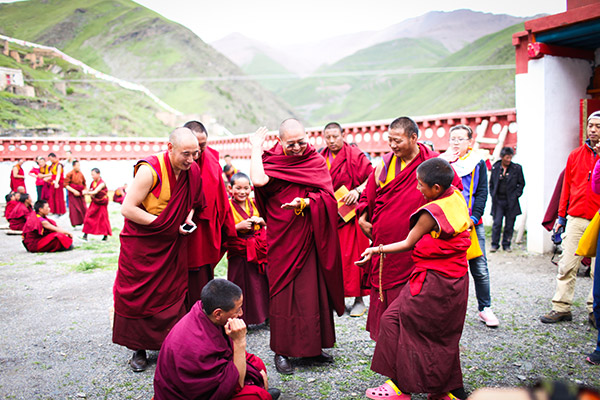The poet with the crimson cassock
By Wen Chihua ( China Daily ) Updated: 2017-07-15 07:11:24
 |
|
Gyatse Phurjun Rinpoche takes part in sutra debatings at the Ba Monastery in Qinghai province.[Photo provided to China Daily] |
"I hope the monastery will provide a place where monks can study Buddhist scriptures, literature, English, and take computer lessons," he says.
Traditionally, a Living Buddha is in charge of a monastery's affairs. And Gyatse Phurjun Rinpoche is no exception.
As for his early life, Gyatse Phurjun Rinpoche was born on May 29, 1981, in Qumarleb county in the Yushu Tibetan autonomous prefecture of Qinghai province.
He is the fifth child and the only son of a herdsmen couple and was known as Sonam Wangchug until 1995.
He was 14 when he was identified as the reincarnation of the 14 Rateng Living Buddha. The announcement came as a complete surprise because his formative years were no different from that of his peers.
In his childhood he performed well in school, and was later admitted to the Communication Technical School in Qinghai province to study civil engineering.
Then, one day, his teacher informed him that his parents wanted him to return home.
It took him three days by bus to get home from the provincial capital Xining.
When he got home, he recalls, "the monks from the Ba Monastery were present.
"My parents had no idea that I was the reincarnated soul boy. But once I learned this, I told the senior monks that I wanted to study the dharma in the best institution in Tibet.
"Otherwise I would be just another Living Buddha unable to offer salvation to sentient beings, but living on their offerings."
In 1996, he was sent to the Sera Monastery in Lhasa, the capital of Tibet, to began his full-time Buddhist dharma education under Khenpo Gashi Ngawang Dadrak.
Sera is one of the three main monasteries in Lhasa, along with Ganden and Drepung, where Tibetan monks undertake advanced studies.
Tibetan Buddhism has four main schools: Nyingma, Sakya, Kagyu and Geluk.
Gyatse Phurjun Rinpoche belongs to Geluk School which adopted the reincarnation ritual in the mid-16th century.
Panchen and Dalai are lineage disciples of Tsongkhapa, the founder of the Geluk School.
Nowadays, reincarnation is largely accepted as an inheritance right among various schools in Tibet.
At the Sera Monastery, he studied Buddhist scripture, Tibetan literature, and history.
And he also attended debates on the sutras, from early in the morning to the late into the night every day.
Then, one day in 2001, his mentor, the Living Buddha Sharu Tong, told him that he should go to live with the Han Chinese.
"My mentor didn't say why or what for. And because of my mentor, I came to Beijing on Sept 11."
In Beijing, he lived with migrant workers in a hostel for several months.
"I remember practicing meditation everyday. I didn't know how to speak Mandarin Chinese, and I didn't have enough money for food, so I only had a slice of bread every day. Water was free at the hostel."
|
|
|
|
|
|
|
|

























 Raymond Zhou:
Raymond Zhou: Pauline D Loh:
Pauline D Loh: Hot Pot
Hot Pot Eco China
Eco China China Dream
China Dream China Face
China Face






